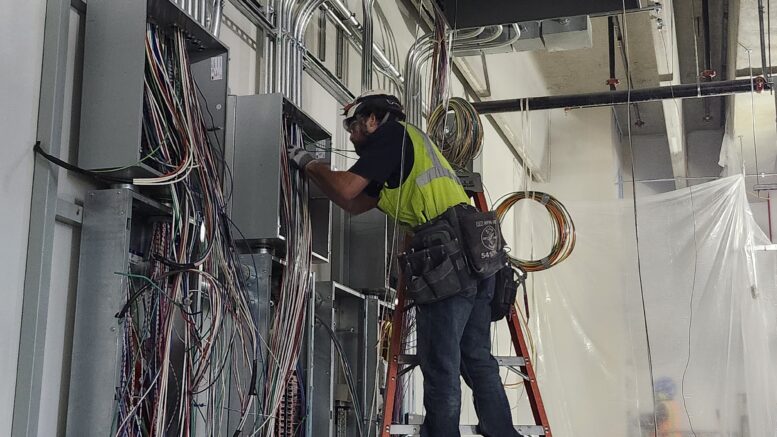In less than three weeks, Colorado employers and educators will begin what many feel is a long-overdue process of identifying the greatest shortages in skills for in-demand jobs and working in partnership to create career pathways to fill those gaps.
As simple as that collaboration may sound on paper, it is an idea that too many business leaders, as well as many K-12 and college officials, say has not germinated due to a lack of communication between the institutions that train the workforce and those who employ it.
And the disconnect between those wanting to work and those wanting to hire workers has never been clearer. Colorado had 134,000 job openings late last year — the highest total of any state, according to the Bureau of Labor Statistics — yet also a 4.4% unemployment rate, demonstrating the poor fit between the skills owned by job seekers and those needed by job creators.
From Feb. 25 through June 3, the Colorado Office of Economic Development and International Trade, together with regional hosts from the local business community, will put on seven Opportunity Now Regional Talent Summits. First suggested in a 2023 report from the business-led Education to Employment Alliance, the summits received funding and structure in a 2024 law and are coming to life now after six months of planning.
What the summits will achieve
Each of the seven daylong events will focus on three priority industries identified by the regional hosts and will gather between 100 and 150 employers, business groups, educational representatives, economic developers and government officials. Attendees will analyze data on talent shortages and create two- and five-year plans seeding or expanding specific pathways, such as, for example, a partnership between local healthcare firms, K-12 schools and a community college to train surgical technicians.
Two statistics lay out why these pathways are so necessary. Since 2020, the number of Colorado high-school graduates moving onto any form of advanced education — whether that be four-year universities, community colleges or specialty training programs — has dipped below 50%. Yet, 92% of the jobs in Colorado that pay wages high enough to sustain a family require some sort of certificate or degree beyond a high-school diploma.
Government officials have asked business leaders before to advise them on their needs, and some business leaders say they are fatigued by such meetings that seemingly haven’t led to solutions. What’s different about these summits is that they’ll bring together all the players needed to create specific and tangible new programs and will give business leaders a direct voice in both plotting solutions and ensuring they come to fruition, organizers say.
“I think this is the first time that we’ve seen this scale of regional coordination occur, and to me that is exciting,” said Kami Welch, president/CEO of the Greater Arvada Chamber of Commerce, which is hosting the second summit. “That is a step in the right direction that will allow us to make real progress.”

Construction workers fix up the 16th Street Mall in Denver. Construction is one of the priority industries for four of the seven Opportunity Now Regional Talent Summits.
How the program will work
While each summit will flow somewhat differently and will have unique focus industries, Yvonne Myers — vice president of strategic initiatives for the Fort Collins Area Chamber of Commerce, the host of the first summit — outlined how a typical day might go. She plans to begin with an overview of research on skilled-talent shortages, move to breakout sessions where attendees discuss how to tackle gaps, offer time for participants to learn about opportunities from apprenticeships to career-pathway management and gather leaders from each priority industry to identify how to create new pathways.
Innovate Work Consulting, a third-party facilitator that has been contracted to oversee the summits, will gather all the information and work with participants to write up the two- and five-year goals, which will go into the annual Colorado Talent Pipeline Report. And leaders from local workforce boards as well as representatives from the business community will follow up with parties identified in the goal documents to ensure plans become pathways.
Myers acknowledged that she, like other regional business-group leaders, has heard complaints from members for years about how they can’t find job applicants with needed skills and are postponing expansion in part because of that. A Colorado Chamber of Commerce survey in 2023 found that respondents ranked the shortage of skilled talent as the second biggest obstacle to their operations in the state, behind only regulations.
Employers who have bellowed those concerns now have an opportunity to sit down with high schools, colleges and workforce-training programs and create the training they need, from short-term certificate programs to longer-term pipelines to get students interested in careers from construction to aerospace, she said. So, it’s important that people who attend the summits not only can identify what is lacking in the current workforce-development system but can commit to being a part of fixing it with the educators they will talk with at these events.
“This puts industry in a very important seat. And they always think that they are not at that seat,” Myers said. “This will drive workforce planning for quite a while … You have to put in your 50% (of the workforce-development effort). You can’t just keep saying ‘Why am I not finding the talent that I want?’”
“The industry voice is leading it”

Eve Lieberman is executive director of the Colorado Office of Economic Development and International Trade.
The summits build on the early phases of the Opportunity Now grant program, which so far has doled out more than $100 million in funds to public-private partnerships, typically between schools and industry groups or businesses, that create new training pathways. Grant recipients have included some 380 employers and 300 education partners, and they have created or grown programs like the Build Strong Academy to boost the construction field and AdvanceEDU to grow the healthcare workforce.
Some ideas from the summits may become future Opportunity Now projects, while others may move quickly from idea to reality through the partnership of schools and employers, OEDIT Executive Director Eve Lieberman said. It will be up to the leaders and participants at each summit to guide regional priorities.
Studies have found Colorado needs 33,500 more construction workers by the end of the decade, 25,000 more workers in advanced-industry fields from bioscience to information technology and nearly 7,000 more advanced-manufacturing workers, she said. And these summits also can help pave the way for nascent but emerging fields like quantum computing that need both workers with advanced educational degrees and many who can move quickly into a sector that pays average salaries above $100,000.
“These summits are going to be transformative in the sense that they are going to drill down on everything that exists already and locate where we need more,” Lieberman said. “And these talent summits are very industry-driven. That’s different in that the industry voice is leading it.”
Summit Calendar
The schedule for the summits, each of which is arranged to focus on the region of the state where the event is located, is as follows:
- Feb. 25 at the University of Northern Colorado in Greeley, hosted by a trio of groups that include the Fort Collins Area Chamber of Commerce with a focus on advanced manufacturing, construction and health care;
- March 18 at the Arvada Center, hosted by the Greater Arvada Chamber of Commerce with a focus on advanced manufacturing, aerospace/defense and renewables/clean energy;
- April 2 at the Pueblo Convention Center, hosted by the Southern Colorado Economic Development District with a focus on advanced manufacturing, construction and health care;
- April 18 at Pikes Peak State College in Colorado Springs, hosted by the Colorado Springs Chamber & Economic Development Corp. and Innovate Pikes Peak with a focus on advanced manufacturing, aerospace/defense and technology;
- May 12 at the Mesa County Workforce Center in Grand Junction, hosted by the Grand Junction Area Chamber of Commerce with a focus on construction, early childhood education and health care;
- May 16 at Fort Lewis College in Durango, hosted by a trio of groups that include the La Plata Economic Development Alliance with a focus on agriculture, health care and technology; and,
- June 3 at Colorado Mountain College in Edwards, hosted by the Vail Valley Partnership with a focus on construction, health care and tourism.
Employers encouraged to contact summit hosts
Because space is limited at each of the events, attendees must receive an invitation. Those employers, business groups and economic-development organizations that are interested in going to any of the summits should reach out to the regional hosts.
Even companies that do not attend — or that are not in one of the targeted industries for each region — will have a role to play in improving the state’s workforce-development system, organizers said. They can participate in the new pathways called for in the two- and five-year plans, will have the opportunity to adapt best practices from those plans for other industries and will be able to form statewide connections from the events to ensure that the voice of employers in curriculum development reaches new volumes.
“I think in five years, when this works, what we’ll see is an interconnected system,” Welch said. “It’s a tall order, but I think that’s the vision we’d all like to see … We will be meeting demand for our industry partners.”
